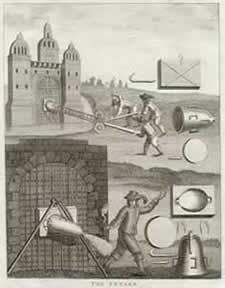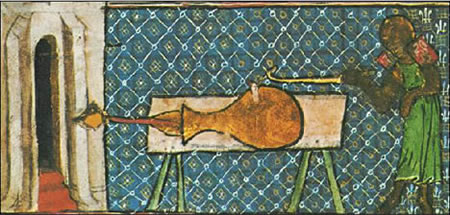Home | Glossary | Resources | Help | Contact Us | Course Map
Archival Notice
This is an archive page that is no longer being updated. It may contain outdated information and links may no longer function as originally intended.
Evolution of Firearms
Building on the student's basic understanding of chemical propellants, this section studies the firearms for which propellants were developed. To fully cover the complete evolution of firearms would take volumes; this section is presented as an overview, intended to stimulate interest in further research by the student.
In its simplest form, a firearm requires
- some means of predictably igniting the propellant,
- some device to facilitate the weapon being held and controlled ( frame or receiver),
- a hollow tube for holding propellant and projectile.
From these three components comes the colloquialism lock, stock, and barrel. The ignition device became known as the lock , the stock is the added support material to make the firearm easier to load, aim, and shoot, and the barrel is the hollow tube.
Early firearms development was based on trial and error. More recently, an engineering approach has been adopted.
This has allowed developers to focus on internal ballistics (interior) considerations, including
- ignition,
- pressure,
- function of chamber design,
- chamber and cartridge dimensions,
- headspace considerations.
The engineering aspects related to these considerations are out of the scope of this module and further information may be found by consulting thermodynamics, chemistry, and metallurgy texts.
Components
The gun barrel probably evolved from the medieval petard. The petard was a bell-shaped metal device open at one end and filled with explosive material. It was placed with the open end touching the door or wall to be breeched. A fuse was lit and the main charge ignited. The shaped metal body of the petard concentrated the force of the explosion on a small area. The principle was a precursor of modern shaped-charge devices used to pierce armor plate.
Large petards were mounted to a framework to hold them against the door or wall. Smaller petards were mounted on long sticks, held by a combat engineer, and used to break smaller items, such as metal locks or door hinges. A hollow tube supported on a stick is similar to our example of a simple firearm. The large petards evolved into cannon and the smaller ones into hand-held firearms.
Projectiles
From the standpoint of technology, the use of propellant materials for throwing nonpenetrating projectiles must be separated from their use for driving penetrating projectiles. An example of a non-penetrating projectile is the Roman candle, which is intended to airburst for entertainment or signaling. An example of a penetrating projectile is a rigid metal ball fired at high velocity.
Like black powder, the actual first use of firearms is lost in history. The first well-dated description and illustration of a penetrating projectile fired from cannon is found in the manuscript (1326) of Walter de Millimete. One illustration clearly shows a large spear loaded in a bottle-shaped cannon pointed at a building. Below, a soldier is shown holding a stick near the touchhole, where cannon barrels are pierced for the fuse.
There are unverified and questionable reports of the use of stone-firing cannon in 1247 in the defense of Seville as well as in 1301, in the German town of Amberg. It is obvious from Millimete and others that the first cannon were used in place of the ballista (a large, crew-served crossbow) to project large arrows and spear-like projectiles.
Frescoes painted by the Italian artist Paolo del Maestro Neri (1343) show foot soldiers holding tubes on sticks pointed at a castle. Wavy lines indicate the escape of smoke or flame from the end of the tubes. Illustrations from the fourteenth century depict soldiers holding a similar unaimed device with the left arm while the right hand holds a lighted, chemically treated rope (match) near the rear of the tube. Because this process is the same as used for lighting cannon via the touchhole, the term cannon lock is used for these small, hand-held cannon.
In the development of small arms, there are four significant areas that drove the evolution of firearms:
- Ignition systems
- Rifled gun barrels
- Breech-loading systems
- Repeating mechanisms
Additional Online Courses
- What Every First Responding Officer Should Know About DNA Evidence
- Collecting DNA Evidence at Property Crime Scenes
- DNA – A Prosecutor’s Practice Notebook
- Crime Scene and DNA Basics
- Laboratory Safety Programs
- DNA Amplification
- Population Genetics and Statistics
- Non-STR DNA Markers: SNPs, Y-STRs, LCN and mtDNA
- Firearms Examiner Training
- Forensic DNA Education for Law Enforcement Decisionmakers
- What Every Investigator and Evidence Technician Should Know About DNA Evidence
- Principles of Forensic DNA for Officers of the Court
- Law 101: Legal Guide for the Forensic Expert
- Laboratory Orientation and Testing of Body Fluids and Tissues
- DNA Extraction and Quantitation
- STR Data Analysis and Interpretation
- Communication Skills, Report Writing, and Courtroom Testimony
- Español for Law Enforcement
- Amplified DNA Product Separation for Forensic Analysts



